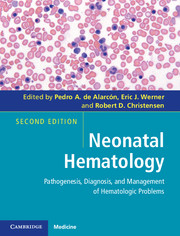Book contents
- Frontmatter
- Contents
- Contributors
- Foreword
- Preface
- 1 A historical review
- Section I Developmental hematology
- Section II Erythrocyte disorders
- Section III Platelet disorders
- Section IV Leukocyte disorders
- 13 Abnormal blood concentrations of eosinophils and neutrophils
- 14 Neutrophil function disorders
- Section V Immunologic disorders
- Section VI Hemostatic disorders
- Section VII Transfusional medicine
- Section VIII Miscellaneous
- Index
- Plate section
- References
13 - Abnormal blood concentrations of eosinophils and neutrophils
from Section IV - Leukocyte disorders
Published online by Cambridge University Press: 05 February 2013
- Frontmatter
- Contents
- Contributors
- Foreword
- Preface
- 1 A historical review
- Section I Developmental hematology
- Section II Erythrocyte disorders
- Section III Platelet disorders
- Section IV Leukocyte disorders
- 13 Abnormal blood concentrations of eosinophils and neutrophils
- 14 Neutrophil function disorders
- Section V Immunologic disorders
- Section VI Hemostatic disorders
- Section VII Transfusional medicine
- Section VIII Miscellaneous
- Index
- Plate section
- References
Summary
Eosinophilia and eosinopenia
Eosinophilia in neonates is identified when the blood concentration of eosinophils exceeds the upper reference range limit. To avoid the potential pitfall of laboratory or technician error, perhaps the definition should be two subsequent eosinophil counts above the upper reference limit. As shown in Fig. 22.17, the 95th percentile for blood concentration of eosinophils increases slightly over the first month following birth. Initially, a count ≥1200/µL would exceed the upper range, and by about 4 weeks a count of above 1500/µL would exceed the upper limit (1). This latter value is similar to that generally used to define eosinophilia in adults (2). Adults with persistent eosinophilia are well advised to have the situation evaluated, because an association has been seen between persistent eosinophilia and end-organ damage (2). Some adults with persistent eosinophilia have elevated blood lnterleulin-5 (IL-5) concentrations (3). Some with hypereosinophilic syndrome have an eosinophilic leukemia involving a translocation in the tyrosine kinase gene (4).
Interleukin-5 (IL-5) probably plays a role as a regulator of eosinophil production. Evidence for this includes the reports of Lee and associates (5) and Dent and coworkers (6) who produced transgenic mice that constitutively over-expressed IL-5. These animals had profound eosinophilia, generally equaling 60% of circulating leukocytes. However, mice with a targeted gene disruption of IL-5 that consequently produce no IL-5, have a reduced number of blood and marrow eosinophils but no other apparent hematologic defects (6). Further evidence that IL-5 regulates eosinophil production comes from studies of Rennick and colleagues (7) and Sher and associates (8) who used specific neutralizing antibody directed against IL-5 and observed that such inhibits the eosinophilia otherwise seen in parasitized mice. More evidence that IL-5 stimulates eosinophil production comes from the work of Lu and colleagues (9) who determined that recombinant murine IL-5 had the greatest effect of any factor tested on colony generation of eosinophilic progenitors.
- Type
- Chapter
- Information
- Neonatal HematologyPathogenesis, Diagnosis, and Management of Hematologic Problems, pp. 209 - 230Publisher: Cambridge University PressPrint publication year: 2013



